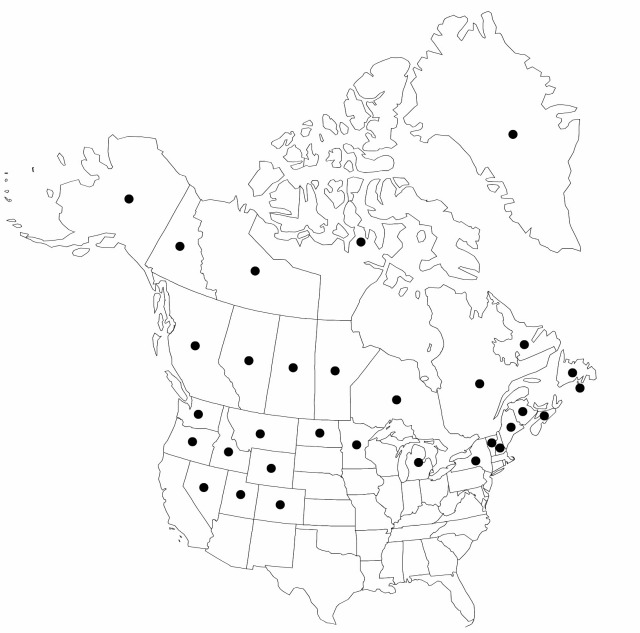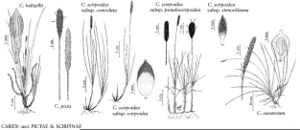Carex scirpoidea subsp. scirpoidea
Plants cespitose; rhizomes short. Culms erect, (5–) 10–35 (–40) cm mm, widest leaves of pistillate culm more than 1.5 mm wide. Leaves: sheaths and bases from previous year’s leaves absent; blades widely V-shaped in cross-section, 31 cm × 2.5 mm. Scales ovate, 2.5 × 1.5 mm. Perigynia ovate, (1.8–) 2–2.5 (–3) × 1–1.2 (–1.5) mm, less than or equal to 2.5 times as long as wide, body tightly enveloping achenes for entire length and width. Achenes 1.5–1.8 × 0.8–1.2 mm.
Phenology: Fruiting late May–Sep, depending on elevation.
Habitat: In calcareous soils
Elevation: 0–1200 m
Distribution

Greenland, St. Pierre and Miquelon, Alta., B.C., Man., N.B., Nfld. and Labr., N.W.T., N.S., Ont., Que., Sask., Yukon, Alaska, Colo., Idaho, Maine, Mich., Minn., Mont., Nev., N.H., N.Y., N.Dak., Oreg., Utah, Vt., Wash., Wyo., Europe (Norway), e Asia (Russian Far East), e Asia (Chukotka)
Discussion
Carex scirpoidea subsp. scirpoidea is the widest ranging of the subspecies and includes taxa formerly recognized by other caricologists. G. Kükenthal (1909) recognized C. scirpoidea var. europaea from a single locality in Norway. These plants are short in stature, like plants of C. scirpoidea subsp. scirpoidea from alpine habitats, and values for most morphologic characters fall within the normal range for subsp. scirpoidea. Another taxon, C. scirpiformis, was recognized by K. K. Mackenzie (1908) and treated at the varietal rank by H. O’Neill and M. Duman (1941) based on wide, hyaline pistillate scale margins and light-colored pubescence. Width of the hyaline portion of the scale margins and the color of pubescence are extremely variable characters in the group. F. J. Hermann (1957) recognized C. athabascensis as a separate species based on the overall robust habit and small, ovoid achenes. Achenes from the type specimens fall at the wide end of the range of variation of achene width in C. scirpoidea.
Carex scirpoidea subsp. scirpoidea is recognized by the lack of persistent leaf bases on the flowering shoots, ovate perigynia that are tightly enveloped by the perigynia on all sides, and leaves widely V-shaped in transverse section.
Selected References
None.
Lower Taxa
"shortened" is not a number.
